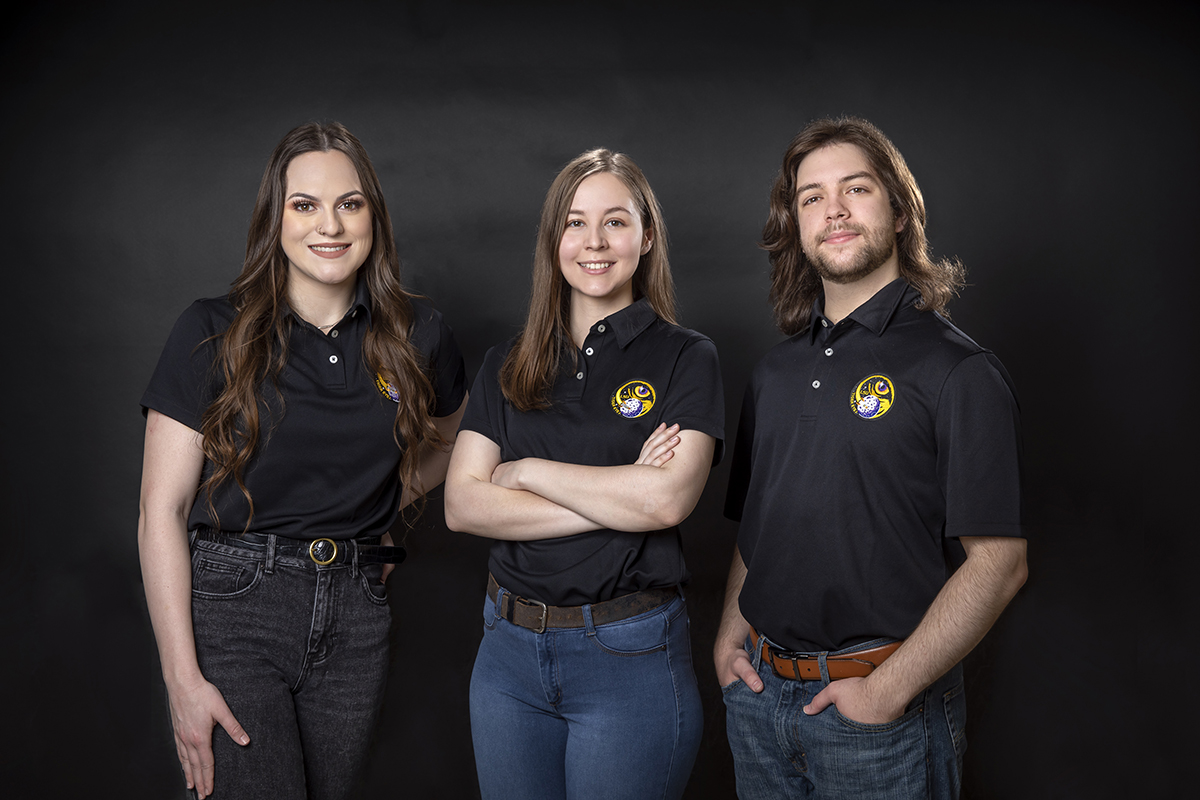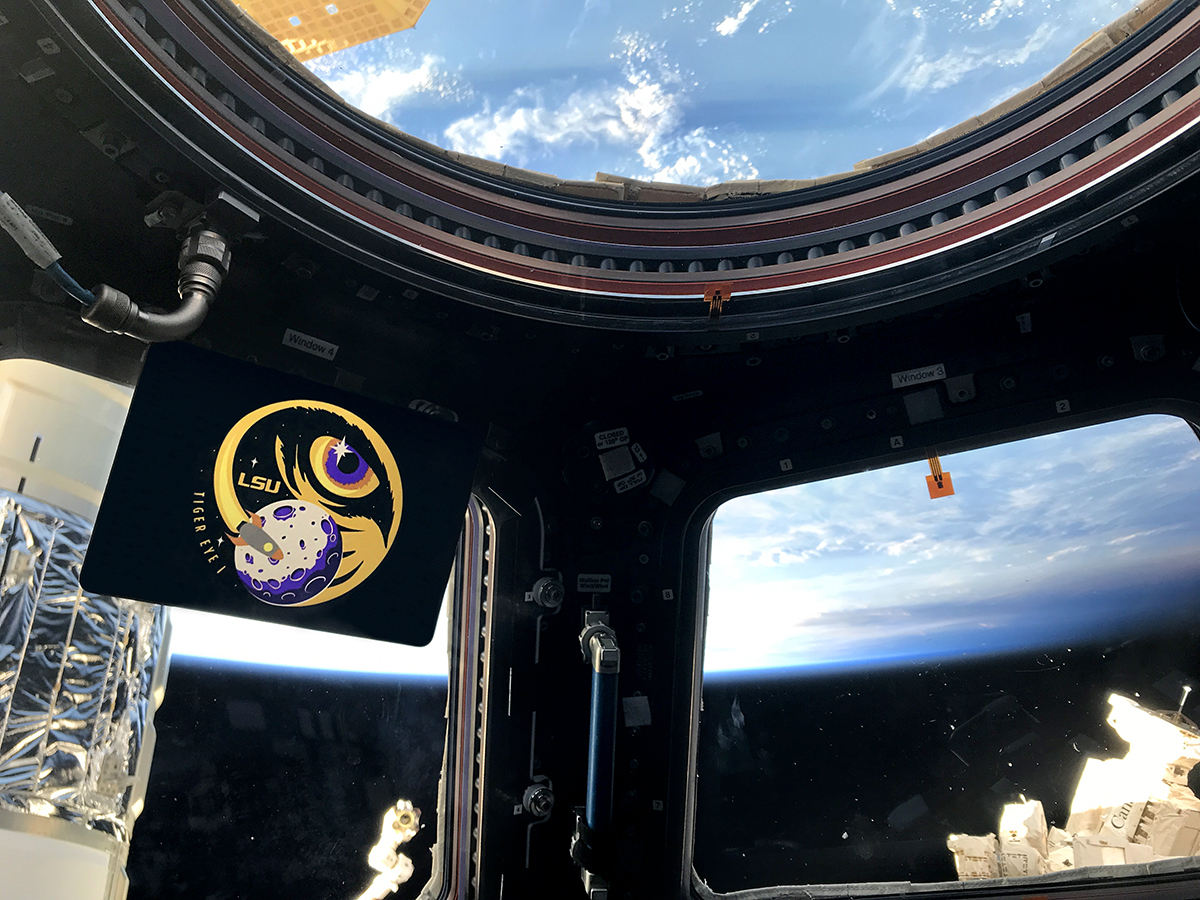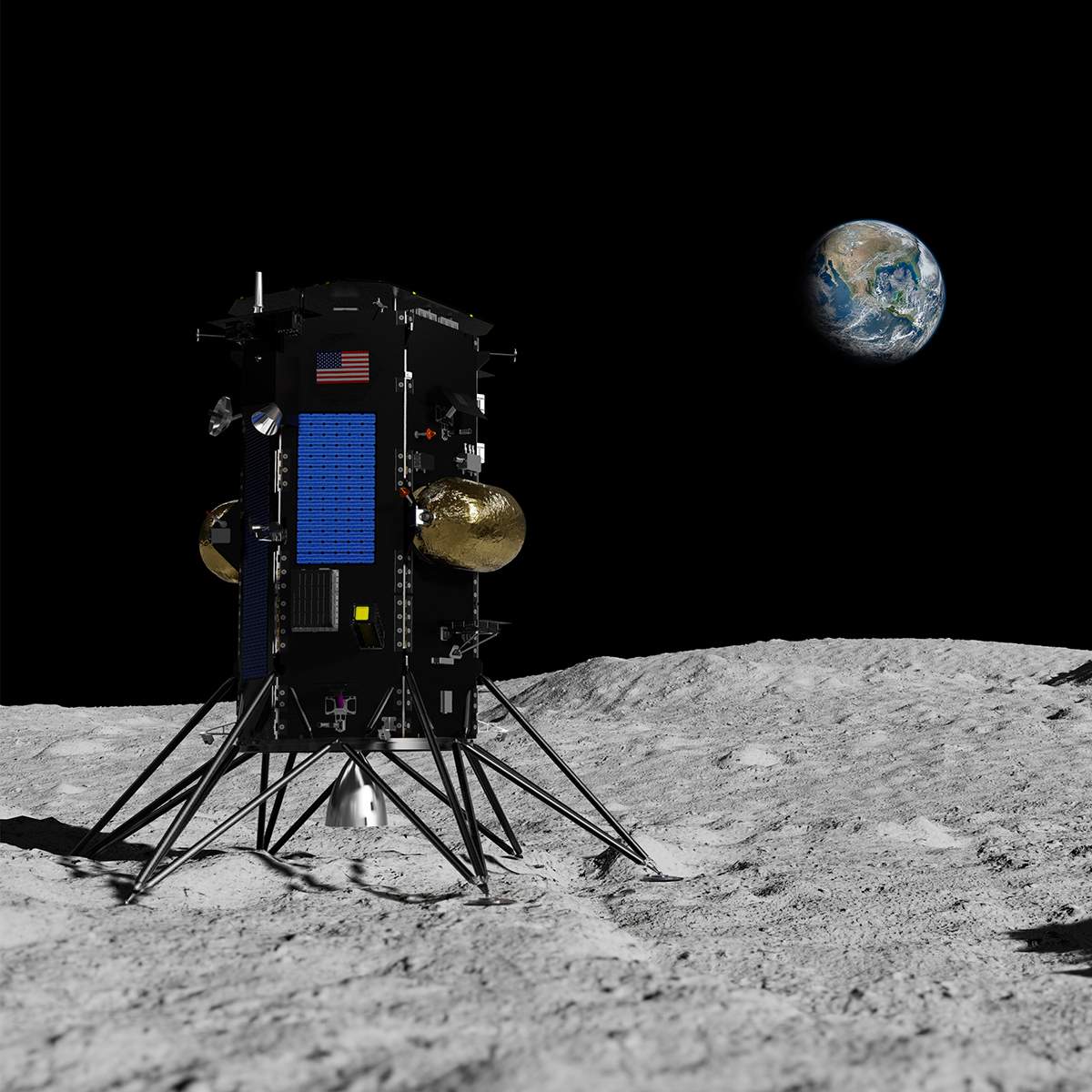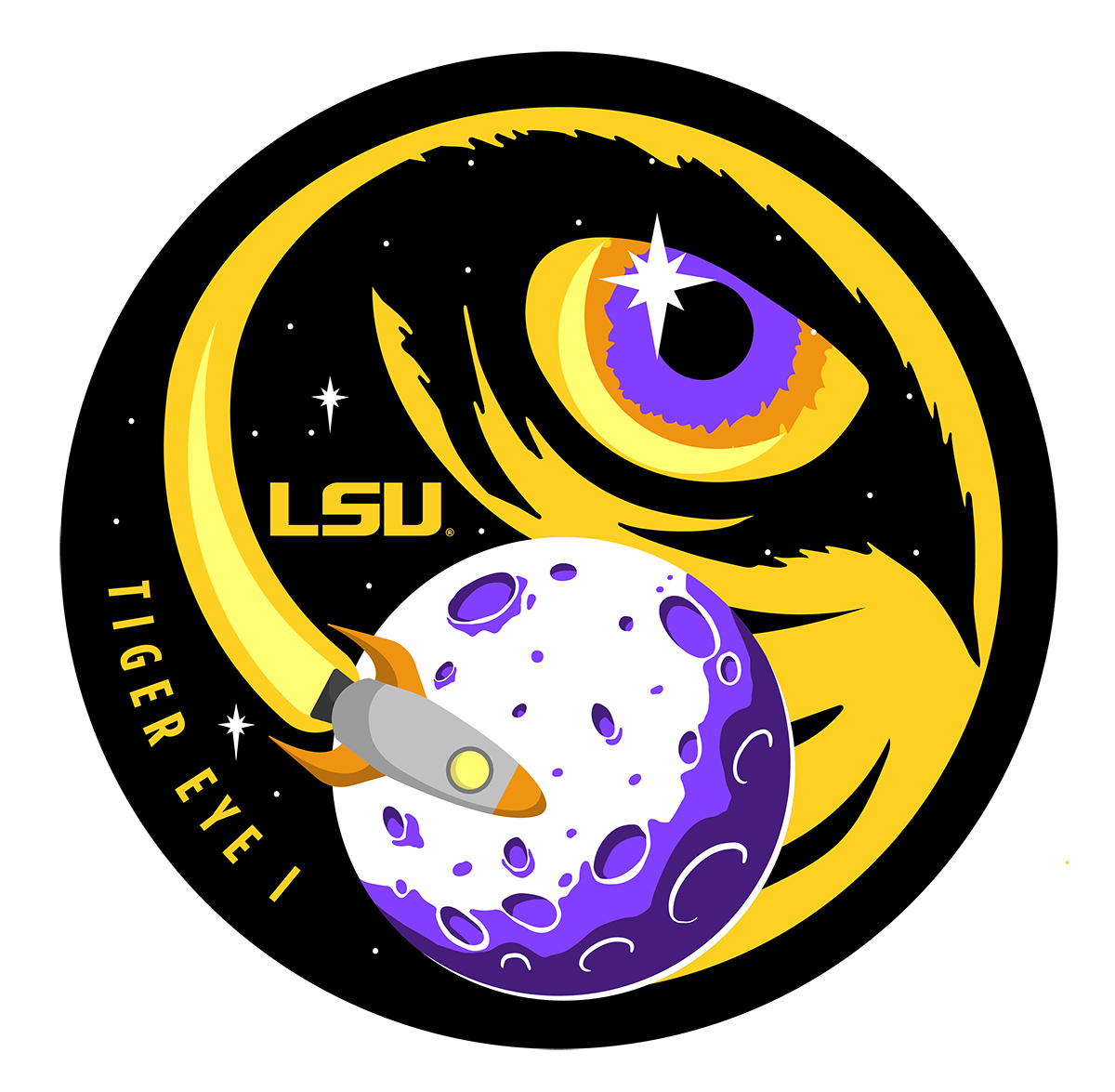LSU Goes to the Moon
May 04, 2021
As the U.S. lands on the Moon next year, for the first time since 1972 and the Apollo program, LSU technology built by students in close collaboration with industry partners will report back from the lunar surface. Undergraduate students in five different LSU colleges and schools are leading the mission, which will make future space travel safer for astronauts and equipment. Meet the team behind Tiger Eye 1.

Students lead the charge. Haley Pellegrin (LSU College of Science), Katie Hostetler (LSU School of Art + Design, LSU College of Humanities & Social Sciences), and Jacob Miller (LSU College of Engineering, LSU Honors College) are helping to lay the foundation for humans to return to the Moon as early as 2024.
– Photo by Eddy Perez/LSU
Next year, Louisiana State University (LSU) will be the first university in the world to put technology on the Moon. The Tiger Eye 1 research mission is part of a multi-disciplinary university-industry collaboration to make future space travel safer for people and equipment by providing insight into the complex radiation environment in space. LSU’s radiation detection device is now officially on the manifest for the broader IM-1 mission, the first in a series of commercial flights (and the first-ever to land on the Moon) that will bring science and technology to the lunar surface through NASA’s Commercial Lunar Payload Services (CLPS) initiative. This will also be the first time the U.S. lands on the Moon since 1972 and the Apollo program.
Students in five different LSU colleges and schools are leading the charge under the direction of Assistant Professor Jeffery Chancellor in the LSU Department of Physics & Astronomy, head of its Space Radiation Transport & Applied Nuclear (SpaRTAN) lab. All are undergraduate seniors from Louisiana:
Haley Pellegrin, from Bourg in Terrebonne Parish, is a LaSpace Undergraduate Research Fellow and member of the SpaRTAN lab where she develops new technologies to make better radiation shielding (LSU College of Science). Jacob Miller, from Crowley in Acadia Parish, is an electrical engineering major who builds new devices for medical applications (LSU College of Engineering, LSU Honors College). Katie Hostetler, from Zachary in East Baton Rouge Parish, is a graphic designer who creates art for LSU Athletics and this spring came up with the winning design for the Tiger Eye 1 mission patch; she’s double-majoring in religious studies (LSU School of Art + Design, LSU College of Humanities & Social Sciences).
“It’s been incredible to see and support all of LSU coming together to move this mission forward.”
Samuel J. Bentley, vice president of research and economic development at LSU
“We’re immensely proud of the LSU students leading this work on the frontier of science, technology, art, and the human imagination,” said Samuel J. Bentley, vice president of research and economic development. “It’s been incredible to see and support all of LSU coming together to move this mission forward. There should be no barriers to expertise, and this university-industry collaboration is a great example of how the caliber of our students and researchers can advance projects of critical importance to our nation.”
“This student-led, cross-campus collaboration reinforces LSU’s impact on space exploration and planetary science,” added Cynthia Peterson, dean of the LSU College of Science. “As we prepare to put people on the Moon again in 2024, we must not only understand what it takes to protect our astronauts, but also what is required to perform science experiments in a space environment and safeguard the technologies needed to conduct the research.”

Test flight. LSU Assistant Professor Jeffery Chancellor, faculty lead for the Tiger Eye 1 mission, holds six NASA grants (including two from LaSpace and two from the Translational Research Institute for Space Health, or TRISH, both NASA-funded) and has previously provided the go/no-go recommendation for NASA space missions. By being on the approved sender list, he was able to email Hostetler’s LSU Tiger Eye 1 mission logo design up to the International Space Station and astronaut Shannon Walker who took a picture of it on her iPad last month, mounted in the clear glass cupola with Earth in the background. Click to see a larger imagePhoto by U.S. Astronaut Shannon Walker
– Photo by U.S. Astronaut Shannon Walker
Through its medical and health physics program and the SpaRTAN lab, LSU helps agencies and companies understand background radiation in space, one of the hard limits on how much time people and equipment can spend out there, beyond the Earth’s protective magnetic field. Understanding the types and amounts of radiation that exist on the Moon will be key to establishing a sustainable human presence on Earth’s nearest neighbor as well as traveling to Mars. The data brought back by Tiger Eye 1 will further the SpaRTAN lab’s research on improved radiation shielding in both materials and design.
“We have models and predictions for human health risk on the Moon, but we don’t yet have actual measurements of the radiation spectrum on the lunar surface,” Chancellor said. “Now that we’ll get real data, we can use it to validate our models, make better predictions, and increase the safety of future space travel.”
The IM in IM-1 stands for Intuitive Machines, a Houston-based company pioneering humanity’s next step—returning the U.S. to the surface of the Moon. IM holds NASA and commercial payload contracts for two separate lunar landings (IM-1 in the first quarter of 2022 and IM-2 in the fourth quarter) to help pave the way for the Artemis program, which will put the first woman and the first person of color on the Moon as early as 2024. The CLPS flights are all uncrewed and will make use of rovers and robots to conduct science experiments and test technologies in different areas on the lunar surface. Intuitive Machines is providing the vehicle, communication network, and mission operations center for LSU’s device to safely land on the Moon and effectively conduct research. IM’s Nova-C lunar lander will be launched from a SpaceX Falcon 9 rocket. The solar battery-driven vehicle will spend two weeks on the surface before succumbing to lunar night, not far from Tranquility Base where Neil Armstrong and Buzz Aldrin first walked on the Moon in July 1969 during the Apollo 11 mission.
“The radiation data we’ll get on IM-1 will change the equation of what’s possible in space.”
Jack “2fish” Fischer, astronaut and vice president of strategic programs at Intuitive Machines, on partnering with LSU
“The two main barriers for human spaceflight are propulsion—how to get there faster—and how to protect humans and equipment from radiation,” said retired Colonel Jack “2fish” Fischer, astronaut and vice president of strategic programs at Intuitive Machines. “Without the shielding and radiation modeling LSU is helping to develop, the radiation effects on crews and equipment during deep space exploration would be catastrophic.”
“Using Jeff Chancellor’s ability to model this stuff and figure out what kind of shielding to use and where to put it, we see a future where it will be much easier and cheaper to go into space because we could open the lunar and space economy to a global supply chain,” Fischer continued. “We could put commercial, off-the-shelf technology out there and lessen the dependency on expensive, overdesigned solutions. The radiation data we’ll get on IM-1 will change the equation of what’s possible in space.”

Device design. One reason for the “Tiger Eye” name: the detectors in the device are configured like a telescope. The radiation enters the aperture, is measured at the first detector, then travels through the material being tested and is measured again at the second detector. This allows the researchers to understand how effective the material is for shielding the cosmic ray environment.
– Illustration by Elsa Hahne/LSU
LSU’s Tiger Eye 1 mission was enabled in partnership with Geocent, a New Orleans-based company that provides solutions and talent for the space, defense, and homeland security communities. Geocent chose LSU as a research and development partner to test some of their radiation shielding, which led to an opportunity to share physical space onboard IM-1.
“Geocent and our teammates—Plasma Processes, the University of Alabama at Birmingham, and the University of Tennessee, Knoxville—are proud to bring Geocent’s ACCRES Radiation Shielding technology to the partnership with LSU and Dr. Jeff Chancellor, Intuitive Machines, and especially LSU students to work on critical research and technologies that truly advance human spaceflight and exploration,” said Robert A. “Bobby” Savoie, CEO of Geocent and LSU Engineering alumni. “We're a national company but Louisiana-born, and it’s thrilling to see students from several disciplines coming together to make significant contributions to an important mission. Geocent’s technical strength is in its people, and we can’t imagine a better way to build talent than challenging students to work together and rise to the occasion to put Tiger Eye 1 and their footprint on the Moon.”
The LSU radiation detection device is currently being customized by Pellegrin and Miller who, as official project manager, also will engage LSU mechanical engineering’s advanced manufacturing and machining capabilities to etch Hostetler’s Tiger Eye 1 mission patch onto the physical device casing, which will occupy a space about the size of an iPhone 12.
“The most challenging thing on missions like these is working within strict limitations on mass, volume, power, bandwidth, and time, as well as communicating with and controlling devices from Earth, which means solving problems no one’s solved before,” Pellegrin said. “I’m super excited to be part of this mission and the knowledge and skills I’ve gained have already kickstarted my career. They helped me land an internship at Geocent, which is a dream come true since I want to work in space and missile systems development.”
“Geocent’s technical strength is in its people, and we can’t imagine a better way to build talent than challenging students to work together and rise to the occasion to put Tiger Eye 1 and their footprint on the Moon.”
Robert A. “Bobby” Savoie, Geocent CEO
Pellegrin and Miller are also working with Advacam, a company based in the Czech Republic, on adapting radiation detection hardware (similar to a USB flash drive) that it has previously supplied for the International Space Station (ISS). But while you can bring laptops and off-the-shelf equipment to ISS to help integrate and connect such devices, that isn’t possible on IM-1. Much of Miller’s work on Tiger Eye 1 lies in software development and coding (and possibly some wiring and soldering) to make sure the data from the sensor “makes sense” to the device, which must be able to communicate with the main Intuitive Machines flight computer to receive time stamps, temperature readings, and other critical data. The LSU team is setting up a Tiger Eye 1 ground control center right on the main campus and hopes to be able to receive raw data as well as issue commands to the device while it is traveling through space and on the lunar surface.
“It’s sort of an engineering and computer science joke, but the amount of problems we solve by turning a device off and back on again is kind of astounding,” Miller said. “So, if we stop being able to communicate with the device or get weird readings, we need to be able to tell the lander to perform a power cycle to reboot our device or change other settings. Rather than just seeing a problem, we need to be able to do something about it without physically touching the device.”

The vehicle. The phone-sized LSU radiation detection device will be mounted on the outside of Intuitive Machines’ Nova-C lunar lander with no mass between itself and the surrounding environment after the lander disconnects from the SpaceX Falcon 9 launch rocket.
– Photo montage by Intuitive Machines
Earlier this year, Pellegin walked the Timepix chip the team will be using as a sensor over to the LSU School of Veterinary Medicine’s linear accelerator (where radiation is used to help treat animals with cancer) for initial testing.
“Most of our patients are dogs and cats, but we do treat the occasional reptile, rabbit, horse, or other pet,” said Jayme Looper, director of the LSU Small Animal Hospital and its radiation oncology services. “Our recent collaboration with the LSU medical physics team to test the radiation detection device prior to its journey to the Moon is an example of a long history of intercollegiate collaboration at LSU.”
Chancellor did the initial characterization of the Timepix technology in the 1990s as a master’s student under advisor Larry Pinsky at the University of Houston, who did the dosimetry for the Apollo mission.
“It takes a lot of time to sort of gather all of the information about how everything communicates and the protocols everybody’s following,” Miller added. “It gets complicated really fast. But as an engineering student, I like the challenge of doing something that’s really, truly new in just a few months. It’s as scary as it’s appealing, and the result is going to benefit human spaceflight for years to come.”
For Hostetler, the design of the mission patch didn’t feel as new as it felt familiar. In a recent LSU Art + Design profile, she shared how her first opportunity to send art into space actually arrived already in fifth grade.
“It was a contest to design a flag to go into space and I was really far ahead in the contest but ended up in second place,” Hostetler remembers. “So, when my professor, Courtney Barr, came to me with the Tiger Eye 1 opportunity, I was like, ‘Fifth-grade me would be proud.’ My mom was especially excited.”
“As an engineering student, I like the challenge of doing something that’s really, truly new in just a few months. It’s as scary as it’s appealing, and the result is going to benefit human spaceflight for years to come.”
Jacob Miller, electrical engineering senior and Tiger Eye 1 project manager
Barr recruited seven undergraduate and graduate art students to come up with 19 different design ideas for the space patch. After careful vetting and input from the other students on his team, Chancellor chose one of Hostetler’s designs, which features a fierce but protective tiger eye overlooking a spacecraft landing on the Moon—because he appreciated the symbolism, and also because “it looked awesome.”
“The patch is an important symbol because it includes everyone on the team,” Chancellor said. “Folks like Danielle Cintron, Darya Courville, Greg Trahan, Shemeka Law, and countless others at LSU have worked really hard behind the scenes to make Tiger Eye 1 possible. Space missions do not happen entirely in a vacuum, and the patch itself helps to represent that idea.”
“I came up with a few different versions, but I’m so glad he picked this one; it’s my favorite,” Hostetler said.

Mission patch. LSU Art + Design senior Katie Hostetler approached the design challenge of creating an iconic patch for the LSU Tiger Eye 1 mission the way she’d previously designed logos, but with more detail. She also researched the history of space patches, which tend to be bold, literal depictions of missions, often with hidden “insider” symbolism that resonates with the core team. She explored various eye shapes before settling on the final design, configured in something close to a yin-yang pattern (balance between the eye and the moon).
– Art by Katie Hostetler/LSU
With an eye on IM-2, Chancellor expects to call on Hostetler and the LSU Art + Design team again soon. Intuitive Machines will bring an ice drill and use a small drone ship to explore hard-to-reach areas on the Moon and test the Nokia 4G LTE network, while LSU is considering sending up a larger and more robust radiation detector, based on lessons to be learned on IM-1. When it comes to shielding materials and design, the vast spectrum of radiation in space doesn’t lend itself to easy or particularly intuitive solutions. You can’t just add more shielding or encase everything in lead. Not only would this add too much mass and cost; shielding in the wrong place could also slow down the radiation particles to the extent they’d get “trapped” inside the space vehicle or the human body, causing devastating damage to astronauts and equipment. Sometimes minimal shielding is the safest option, and the LSU SpaRTAN lab’s research will continue to help the aerospace industry find out exactly where and when and how to effectively use it.
The upcoming missions reflect the importance and impact of LSU’s Space Grant status, supporting critical space research across a range of topics. LSU manages the National Center for Advanced Manufacturing (NCAM), a partnership between the university, NASA, the State of Louisiana, the University of New Orleans (UNO), and the UNO Research and Technology Foundation focused on applying advanced manufacturing technologies in support of NASA space programs. NCAM is located at NASA’s Michoud Assembly Facility in New Orleans, where critical hardware components for exploration vehicles—such as core Space Launch System (SLS) rocket components for NASA’s Artemis mission to the Moon—are engineered, manufactured, and tested. Beyond state-of-the-art research, NCAM has a strong educational and talent development mission, working with aerospace companies to build the next generation of scientists and engineers.
“We’re especially excited about the tremendous opportunity Tiger Eye 1 is for LSU students to be involved in forefront space-science research.”
Jeffrey Blackmon, chair of the LSU Department of Physics & Astronomy
“With NASA’s Johnson, Stennis, Michoud, and Marshall Space Centers all within arm’s reach, LSU is helping to develop the workforce needed for the next step in space exploration—long-term, crewed space missions and a return to the lunar surface,” said Jeffrey Blackmon, chair of the LSU Department of Physics & Astronomy. “The Louisiana Space Consortium (LaSPACE) and the High-Altitude Student Platform (HASP) have played major roles, but we’re especially excited about the tremendous opportunity Tiger Eye 1 is for LSU students to be involved in forefront space-science research.”
As the Tiger Eye 1 team works to get everything ready for launch, something else just came up—the LSU SpaRTAN lab will be flying yet another radiation detector on SpaceX’s Inspiration4 mission using their Falcon 9 launch vehicle and Dragon spacecraft this September, in collaboration with Pinsky. It will launch from NASA’s Kennedy Space Center in Florida and be the world’s first all-commercial, all-civilian mission to space. It will circle the Earth before making a soft water landing off the Florida coast. This will be another opportunity for LSU students to form a team in support of a space mission. The team will include Jared Taylor, graduate student in medical physics who will integrate the related research into his Ph.D. project, and Duncan Wilkie, undergraduate student in physics. At least one additional student will be announced soon.
Shirts, hats, etc. bearing the LSU student-designed Tiger Eye 1 mission logo are now available through the Designs on the Geaux online store. Proceeds will support future student involvement in space research.